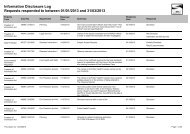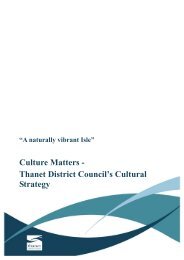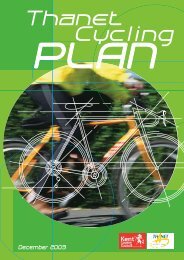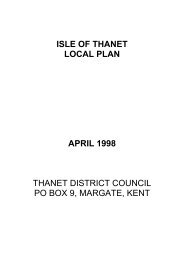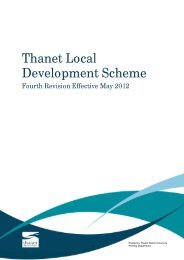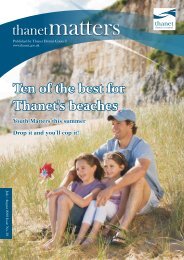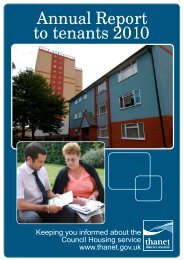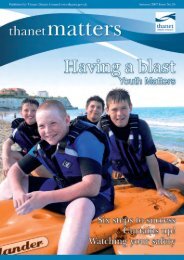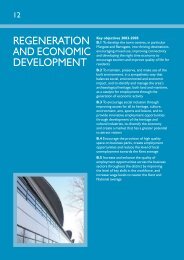Review of existing Section 106 Agreement - Thanet District Council
Review of existing Section 106 Agreement - Thanet District Council
Review of existing Section 106 Agreement - Thanet District Council
Create successful ePaper yourself
Turn your PDF publications into a flip-book with our unique Google optimized e-Paper software.
5 KIA – Future Development and AirportBusiness Needs5.1 Future development <strong>of</strong> KIAKIA initially developed as a specialist freight airport, although the airporthandled some specialist passenger charters, predominantly to the FormerYugoslavia during the 1960s and 1970s. Specialist dedicated freighteroperations continue, although its main based airline, MK Airlines, moved to anew base at Ostend in Belgium in August 2004. There are still some ad-hocfreighter flights, mainly emergency relief and aircraft visiting the specialistmaintenance centre, Jet Support. KIA’s owner, Planestation, have however,stated that they intend to find another home-based freighter operator toreplace MK Airlines.Although KIA have attempted to attract passenger flights over the past fiveyears, until August 2004, this was mainly restricted to the occasional charterfor cruise liners sailing from Dover. In August 2004, however, a new low-costairline, EUjet, started operating from KIA to some 19 UK and Europeandestinations using Fokker F100 aircraft. Planestation subsequently acquired a60 percent shareholding in EUjet.Unlike other low-cost airlines (with the exception <strong>of</strong> Flybe), EUjet do not utiliseaircraft within the 140-180 seat range (eg B737/A319/A320), but insteaddeploy a fleet <strong>of</strong> Fokker F100 aircraft. These have a more limited range,seating capacity and cruising speed although, they may, in somecircumstances, be more commercially viable for certain routes. The feasibleflight schedules will be dependent on sector length and turnround times, buttypically three daily rotations to destinations in western Europe (eg southernSpain and Portugal) would require an initial departure ex-KIA in the earlymorning (0600-0700 hours) and a final return to base at between 2300-2400hours). Given the nature <strong>of</strong> the fleet and the typical sector lengths for many <strong>of</strong>EUjet’s routes, it is difficult to avoid a number <strong>of</strong> arrival flights into KIA in thelate evening.5.2 Forecasted traffic growth and implications for aircraft noiseEUjet have stated that they expect to carry some 300,000 passengers throughKIA in its first year <strong>of</strong> operation. This is expected to rise to 2 millionpassengers per annum by the end <strong>of</strong> the third year <strong>of</strong> operation. Longer-termtraffic projections (eg in ‘Strategic Master Plan for the Development <strong>of</strong>Manston Airport’, Arthur D Little, March 2001) suggest that traffic might rise to3.5 million by 2010 and to 4.4 million by 2015. These longer-term projections,are however, beyond the scope <strong>of</strong> this particular exercise.We understand that the latest noise contours produced (Bickerdike AllenPartners – February/March 2002 – Appendix A) show daytime LAeq, 16 hrnoise contours for the Summer Periods 2000 and 2001 and the Annual Period26/9/00-26/9/01. These were based on the actual traffic mix (ATMs) duringthese periods. Forecasted noise contours were also prepared for Summer2005, based on the then-projected traffic mix <strong>of</strong> dedicated freighter aircraft andpassenger aircraft (2 mppa). The analysis was on a total <strong>of</strong> 14,880 ATMs, <strong>of</strong>EU00142:FINAL REPORT PAGE 23



